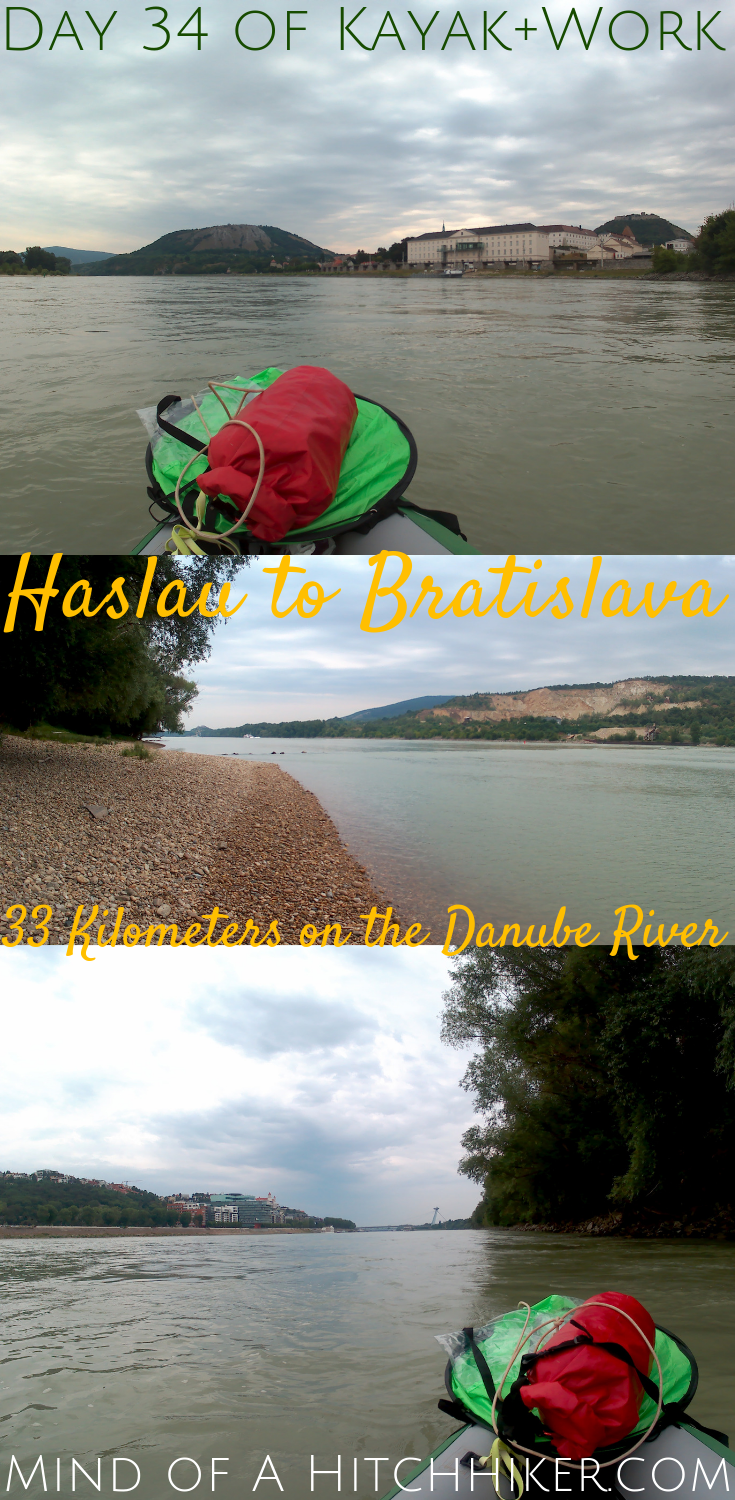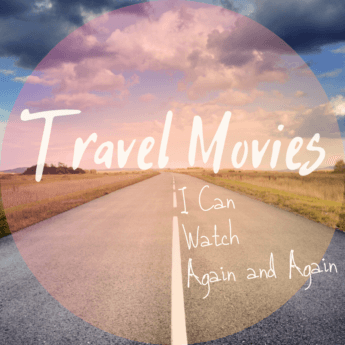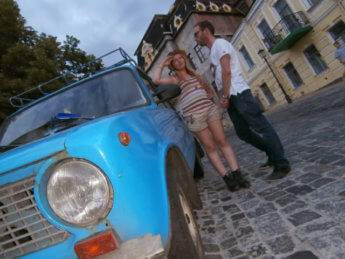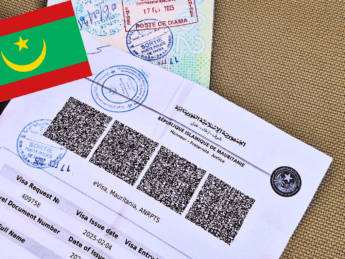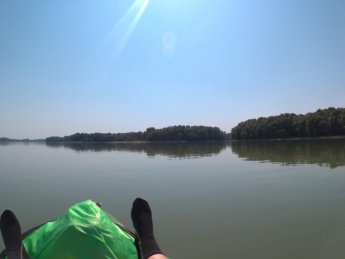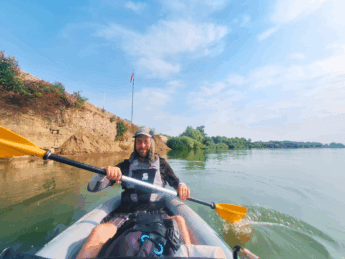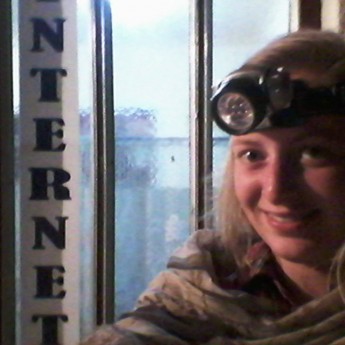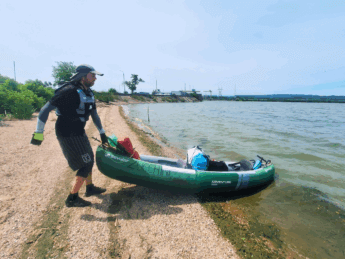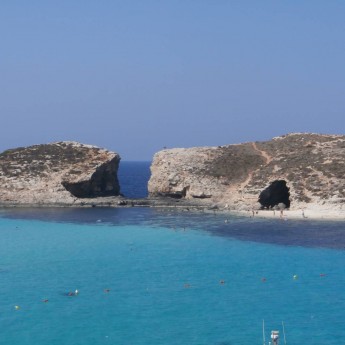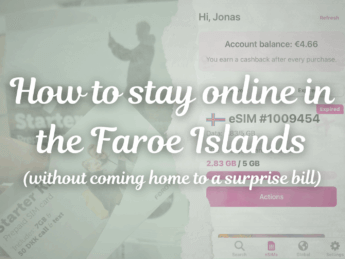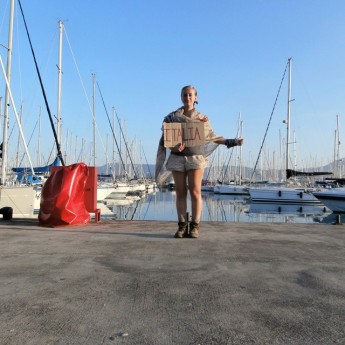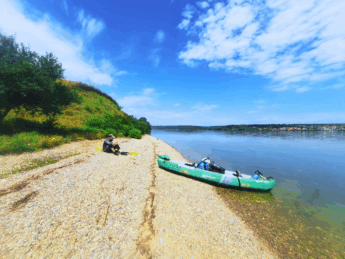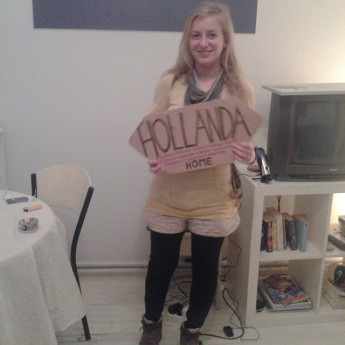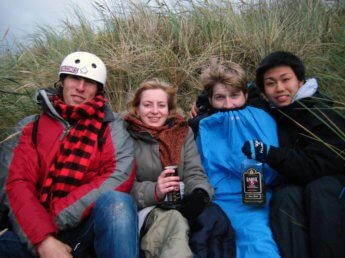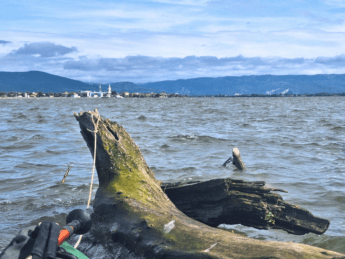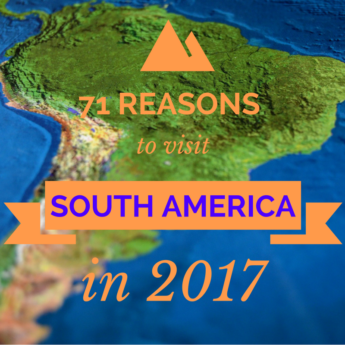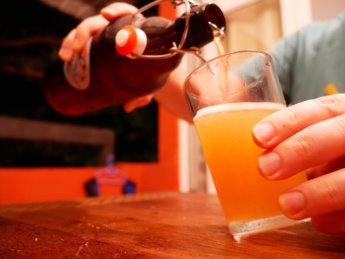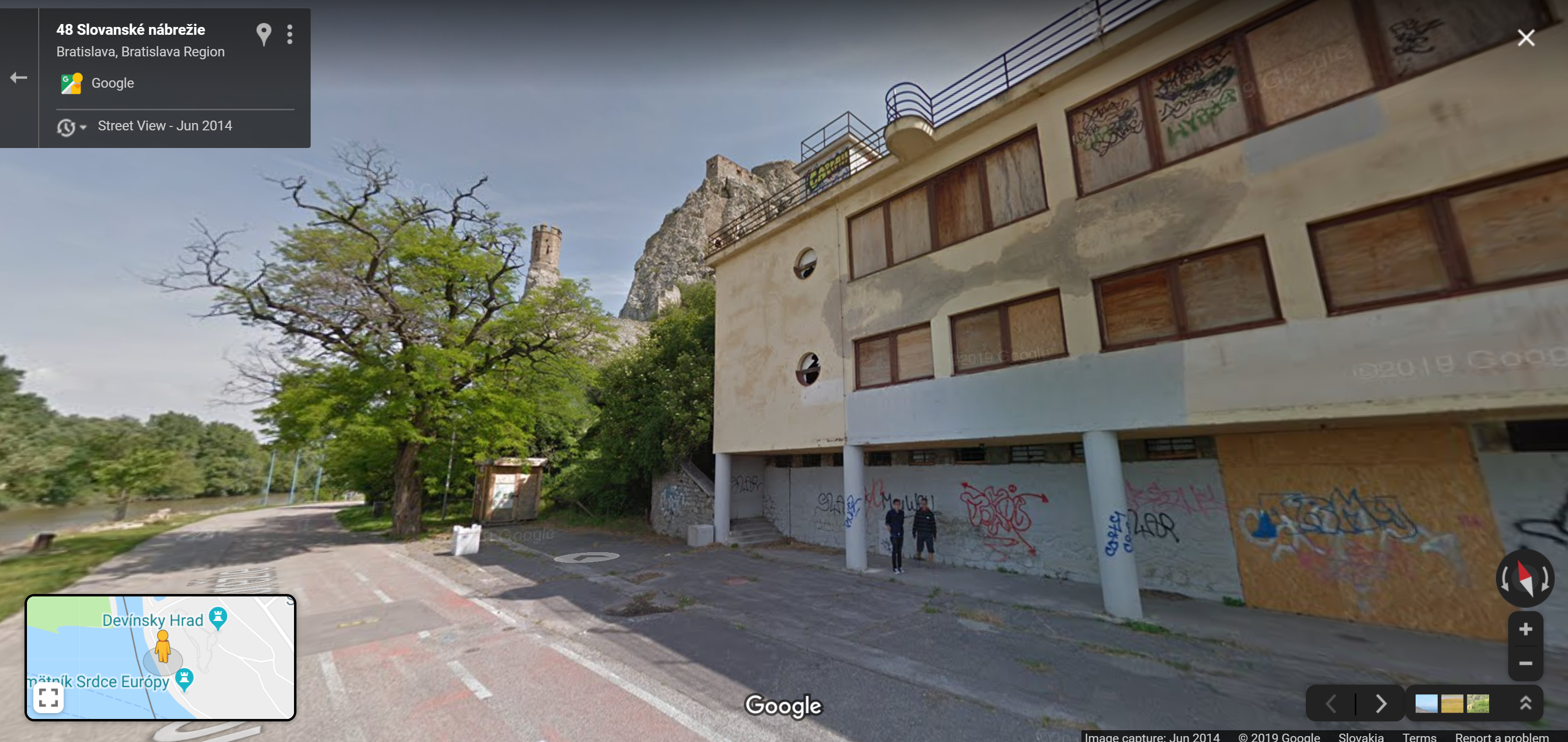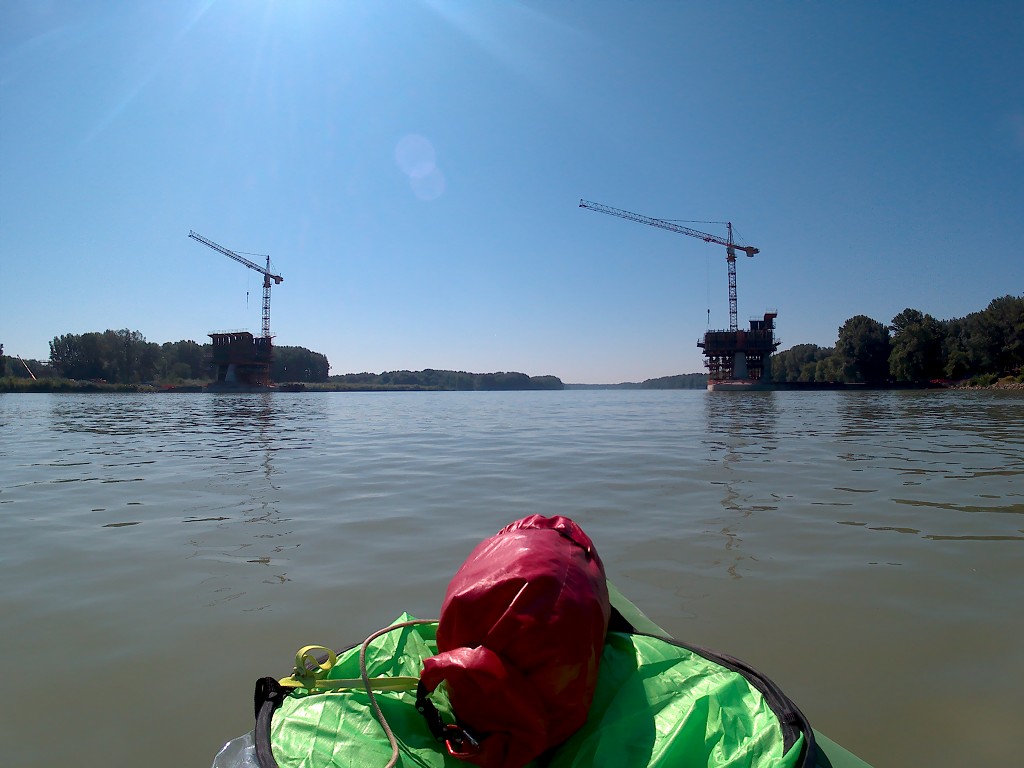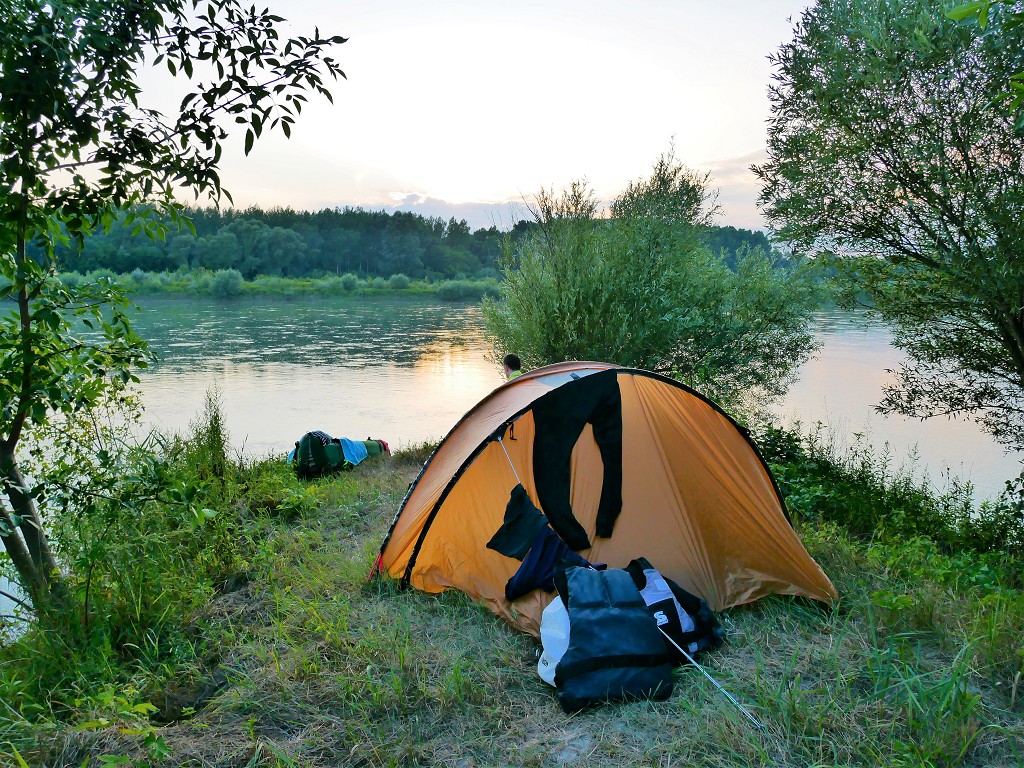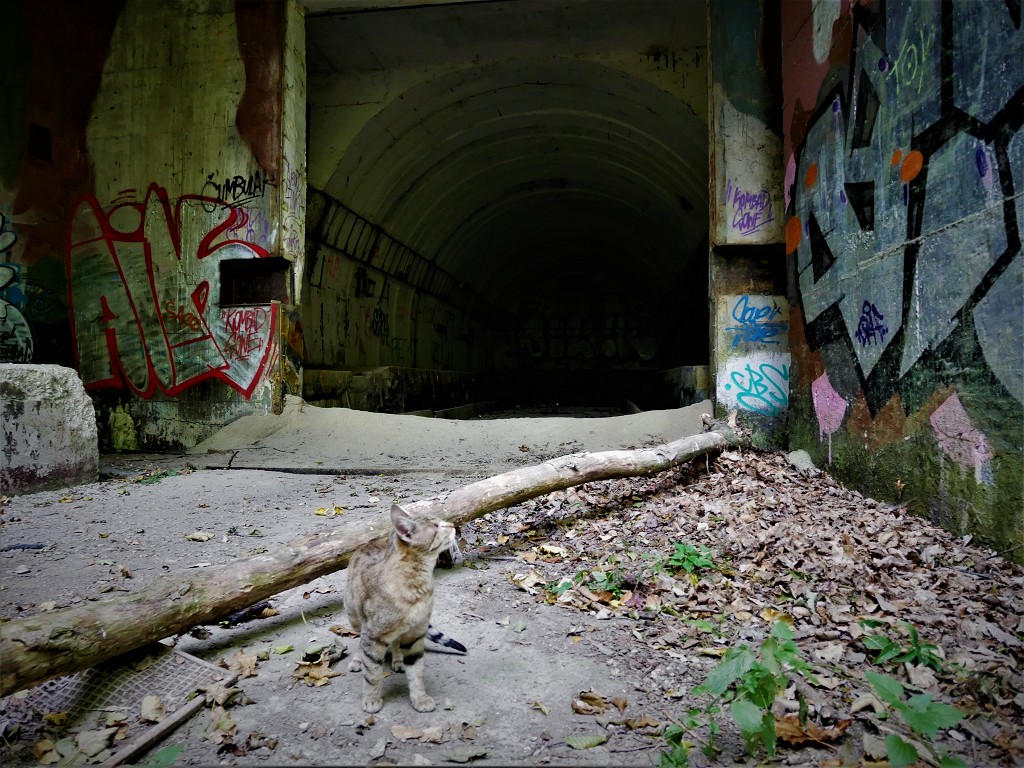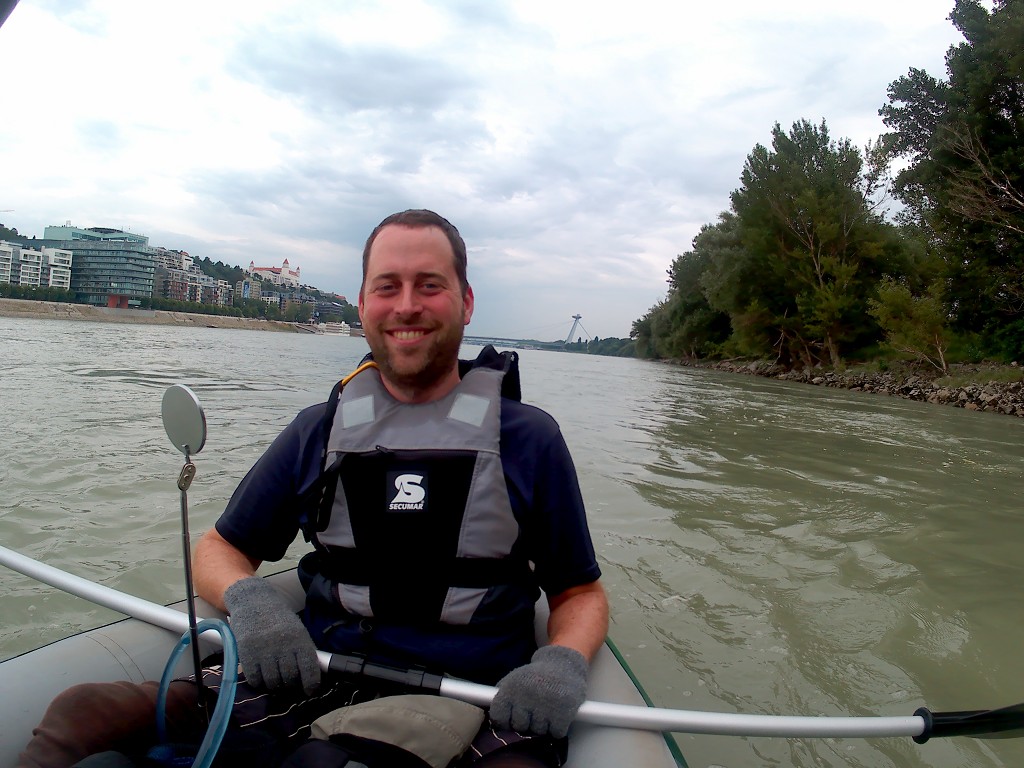
Events described… happened on August 2nd, 2019. We paddled down the Danube river from Haslau an der Donau in Austria to Bratislava, the capital city of Slovakia. This is the third country we’re paddling in on our long-distance kayak trip.
Unfortunately, when editing the videos for this post and the previous one (Day 32), I accidentally deleted all of them from the tiny camera’s SD card. Yes, we’ve tried every recovery program in the world. Yes, I am angry with myself. So all the videos (if any) for this post come from my phone camera.
Want to travel the (entire) Danube River in an adventurous way? Join our Facebook group Danube River Source to Sea: Kayak / Canoe / Bike / Hike / Sail to find your community
Our Stay in Haslau
We didn’t do much in Haslau besides working and dodging the heat and testing a dehydrated pasta meal on our camping stove. The Airbnb had a pool, but it was unfortunately not for guests. I wrote a bit and edited some posts with the good WiFi that we made great with our signal booster box. Our sudden proximity to Slovakia also prompted us to research the next stretch after Bratislava and to book some places.
The stretch after Bratislava is a little special because the Danube splits up again in manifold ways. This is because the river now enters a geographical zone named the Pannonian plain, which means the river can meander and do whatever it wants in this flat area. There are three choices:
- The Little Danube (Malý Dunaj) which splits up left on the outskirts of Bratislava to travel 128 kilometers around the biggest river island of Europe (named Veľký Žitný Ostrov) only to rejoin the navigable (by big ships) Danube again via the river Váh at the town of Komárno.
- The cargo and cruise ship Danube that starts at the Čunovo dam and leads up to the Gabčíkovo dam (vodné dielo Gabčíkovo).
- The main Danube that forms the border between Slovakia (left) and Hungary (right). It also starts after the Čunovo dam, but the river is left free to meander, unlike the canalized previous option. It’s not navigable by big ships, only motorboats and tiny boats like ours. It’s a wild area with sparse civilization and it’s about 60 kilometers long. We’d have to freecamp for one night at the very least and make sure to take enough drinking water.
We never really contemplated the first choice but didn’t know what to do between the latter two. The Tour International Danubien (TID) takes the border route. We decide to do the same and freecamp one night. Once we decided, we book the places we now know we can safely book ahead.
At our Airbnb in Haslau, we grilled our leftover sandwiches from the previous paddle day on my camping stove. In the evening, we ate some ‘just add water’ meal from a shop to test it out as a camping meal for when we go freecamp ten days from now.
Then it’s time to pack up our life again in our dry bags. I’m super excited to finally return to Bratislava. It will be Jonas’ first time in Slovakia and I’m very excited for him, too. After so many months in Germanophone lands, I’m very ready to hear some Slavic language again.
Leaving Haslau for Bratislava
We wake up at 6:00 and leave the house at 7:00. This time we’re not leaving early because of the forecasted heat, but because of the Twin City Liner’s schedule; if we’d like to not get out of the river within the first hour of paddling, we need to leave this early. Because of the distance, we’re both wearing our hiking boots until we get to the river.
We walk past the cute tiny church in Haslau where there’s a lady with a bicycle either taking care of the flowers or stealing them. The hike down the path is again very tough for me with the big backpack and the three paddles. My legs cramp, my shoulders cramp, and I’m in a lot of pain. I take a break at the same bench I was at two days earlier to relax my muscles a bit before pushing for the final two hundred meters. At the spot, I drop the backpack. My back pain got worse from that little stint down the hill, but Jonas promised me to make a decision about the paddles today.
When pumping up the boat, my back starts hurting so badly that Jonas has to finish the job. This is really not good. We both change our land shoes for river shoes. Once it’s all ready, I first carry the paddles to the river’s shore. It’s a longer way than it looks and the ground has become very muddy and slippery, probably because of the morning dew. The water levels are also lower than they were when we arrived here. I walk back to Jonas to help carry the boat to the water. I tell him to try to walk over the grassy parts as much as possible because the rest is too slippery. He walks over the pure mud parts despite my warnings and we slither over the ground all the way to the shoreline. Somehow, neither of us fell down.
Warming Up
We’re paddling at 7:55. It’s slightly cloudy today and the current is still strong. Jonas uses his new black paddle until I ask to switch with him. I’m also curious about this flat paddle that’s a good 10 centimeters longer than my blue paddle. It’s much heavier than my own, but it has a lot of power. The blade is very big and there’s a lot of effect from a simple stroke. But it’s also incredibly tiring. By the time we switch back our paddles, I’m completely warmed up. My own paddle is so light by comparison. It would probably make sense to find the exact same paddle as mine for Jonas when we continue this trip again in two years. It’s simply the best paddle.

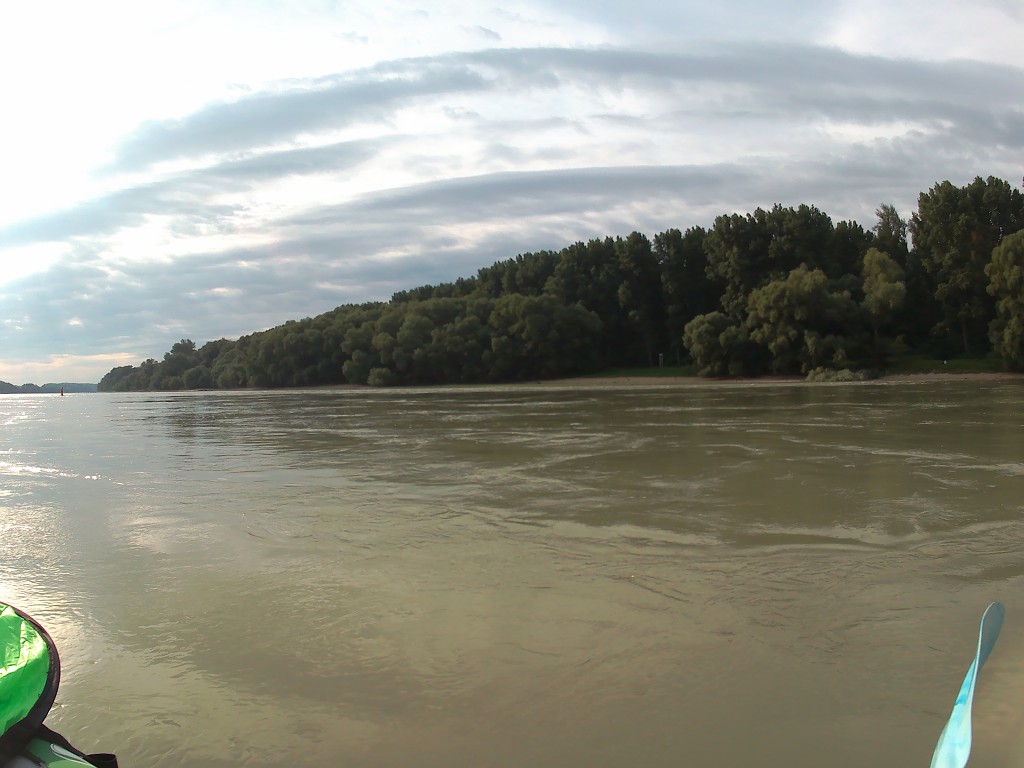
At 8:20, we encounter the first cruise ship of the day. Carissima is its name. Then a few cargo ships appear here and there. At 8:30 we know the Twin City Liner left Vienna for its first voyage of the day. We pass a town called Wildungsmauer, which has a nice slipway. In hindsight, it would have totally been possible to paddle all the way from Vienna to Wildungsmauer or even Hainburg in one day. The flow speed is still so good here, perhaps it would even be doable to paddle the whole 60 kilometers from Vienna to Bratislava in one day. But yes… in hindsight. Perhaps my back wouldn’t hurt like hell if we’d just pushed through since we weren’t even really tired upon arrival in Haslau.
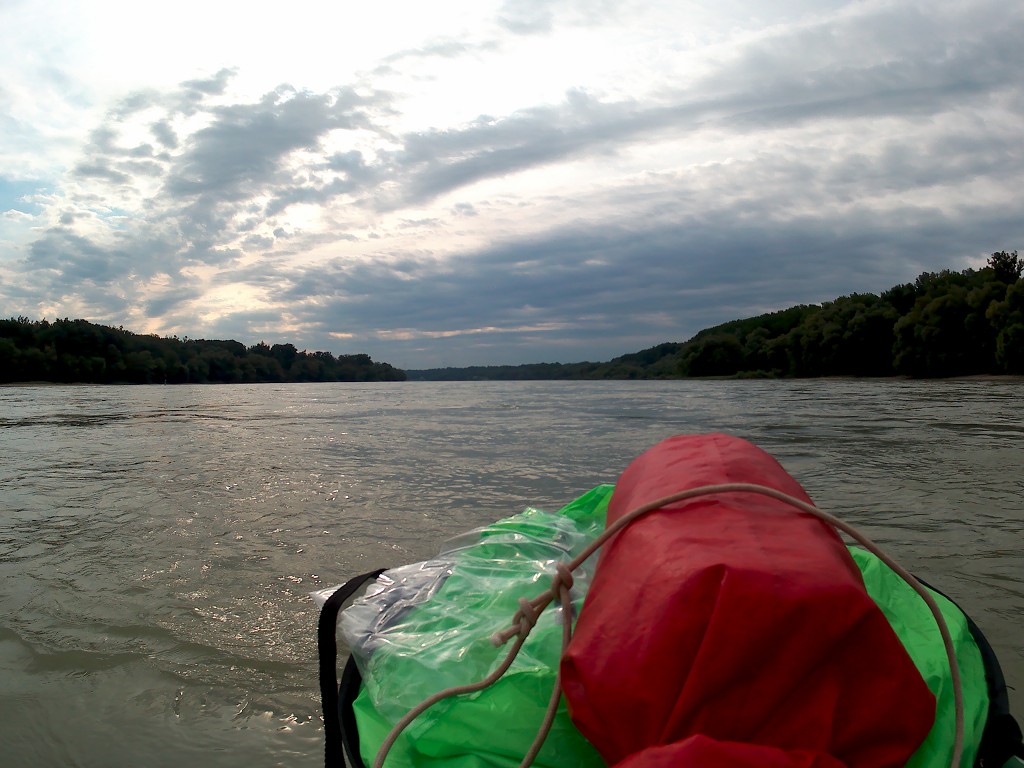
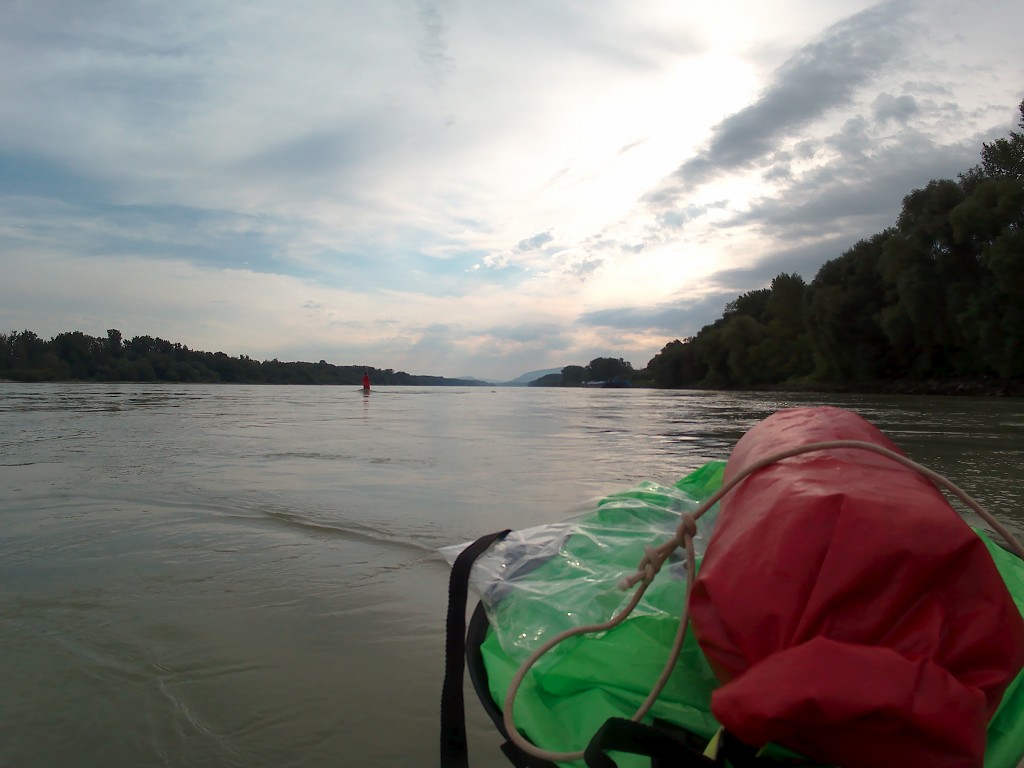
The right-hand shore of this Nationalpark Donau-Auen has been a bit funny the entire way; there’s a little backwater or floodplain behind the shoreline that’s on a lower level than the main river. Sometimes there’s a little water spilling over from our river into the sidearm, and then it rejoins again after a few kilometers into the main Danube. There are still warning signs for paddlers that this area is dangerous, but we’re confident this only applies when the Danube floods. I’d thought about paddling through there before, but what I’d seen in Haslau was that these areas were too shallow or overgrown for such an adventure. And since it’s a protected area it might even be illegal to paddle there.
The First Encounter
Jonas’ Twin City Liner alarm goes off at 9:00. We find a spot to leave the water within five minutes between some tricky speedbumps. We land our boat and get out at 9:10, take a break, and eat a sandwich. Jonas wants to eat one of his chocolates, but then the ferry shows up. He puts it down on a stone, which I think is a mistake in case the waves get that high.
We hold on to the boat while the ferry passes. The first waves are fine and don’t threaten our boat much. But then the waves bounce back on the shore and come form all kinds of directions. A big wave hits the stern of our boat and a big sploosh of water goes over Jonas’ seat. Shit. Zucchini gets pushed onto the shore and we’re a bit pissed we didn’t prevent this wave action from wetting our boat.
We get back into the boat and continue paddling downstream at 9:25. Out of nowhere, the sister ferry of the Twin City Liner pops up from downstream. It’s the hydrofoil model. We don’t know its schedule at all, so this came out of nowhere. Luckily, this ferry doesn’t really cause any waves, so we stay in the boat and don’t even have to turn our boat into the minimal waves.
Then Jonas tells me he forgot his chocolate. He was really looking forward to eating that. He asks me if perhaps he put it back in the packaging (there were two chocolates left) and I tell him I’m sure he didn’t put it back. Jonas is really sad and disappointed, and I’m getting a bit irritated. We’ve tried really hard not to pollute the Danube and its shores on this trip, and now a piece of dark chocolate in a mixed-materials packaging is lying on some rock somewhere as litter. Jonas is most of all frustrated because of the anticipation to eat it, and secondarily about the pollution. It spoils the mood a bit.
Passing Bad Deutsch-Altenburg and Hainburg
We pass under the Andreas-Maurer-Brücke, which is the last bridge over the Danube in Austria. To the right is the village Bad Deutsch-Altenburg, quickly followed by Hainburg. There are quite some unmapped speedbumps in the water that make navigation a bit tricky. Most of the time, we’re paddling in the shipping lane with the big boats.
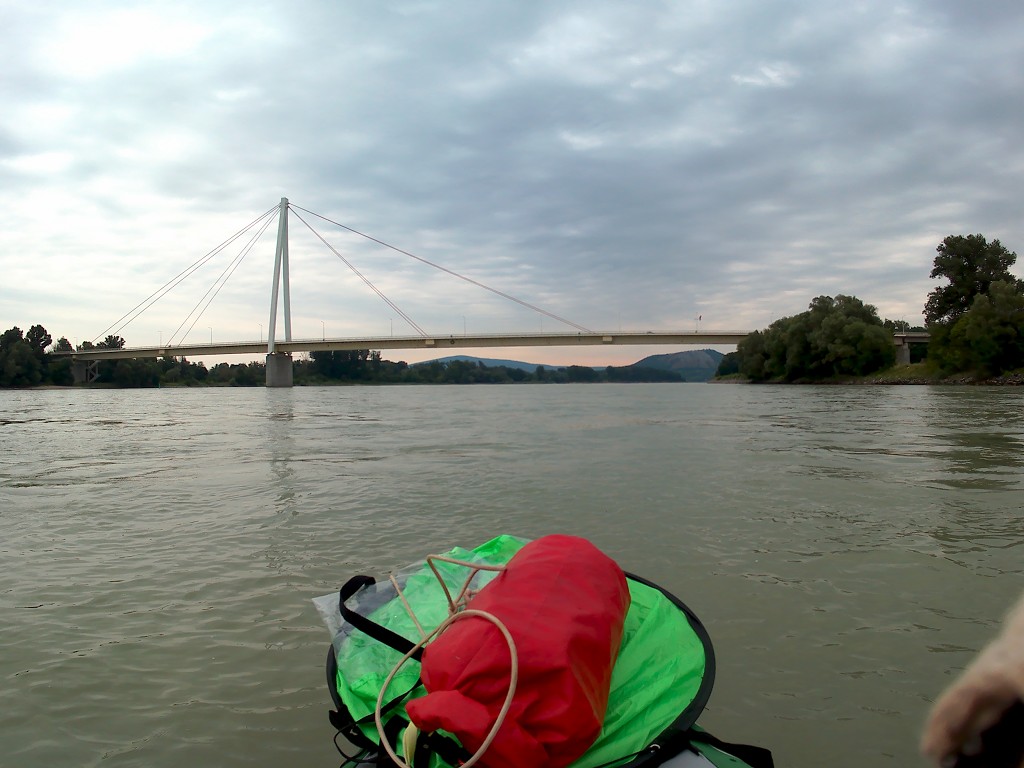

Hainburg is the last Austrian town on the Danube with a proper cruise ship dock. The town is surrounded by beautiful hills, including the flat-topped Schlossberg (castle hill) and the Braunsberg. These are geomorphologically already part of the Western Carpathian mountains or more specifically, the Little Carpathians. I told Jonas I find it incredibly cool that we paddled so far we changed one mountain range (the Alps) for another. And it’s this river that keeps the two ranges from meeting one another. There is a vague description of the two ranges meeting at the Leitha Mountains, but I can’t really find out how that’s supposed to work then if the Danube has to pass between.
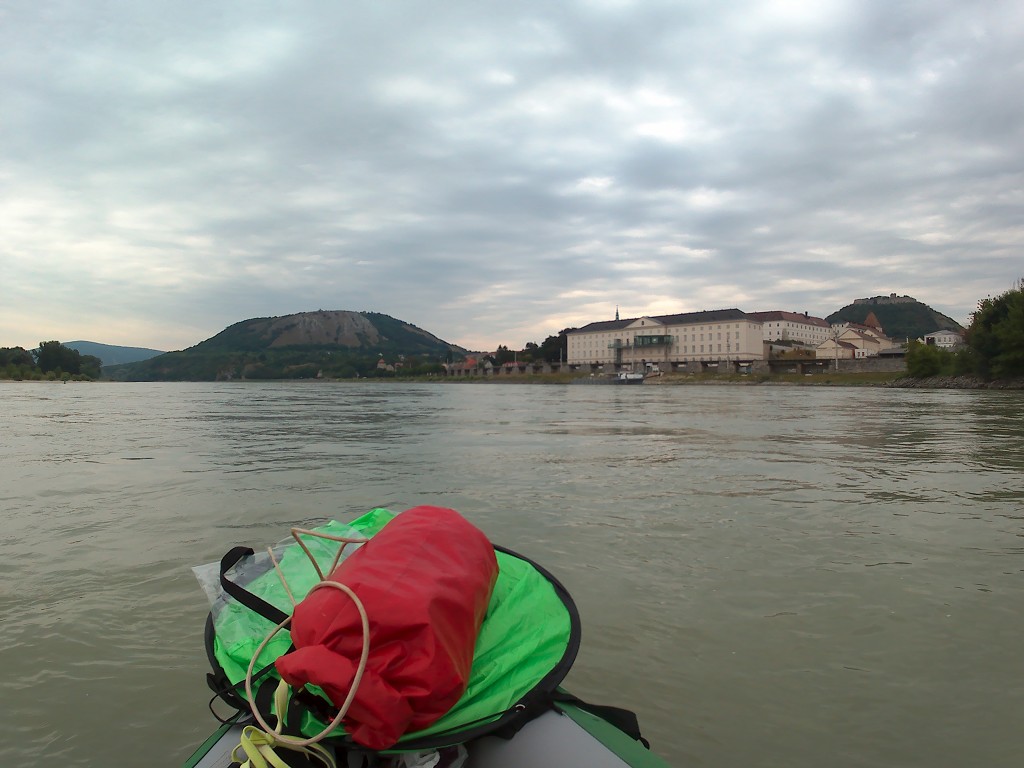
A Slovakian cargo ship by the name of Christiane travels upstream and the captain waves at us from inside his cabin. It’s still weird to see how our relationship to the cargo ships has changed so much since Kelheim and Regensburg.
By 9:55 we’re outside of Hainburg about to enter a river bend named the Hainburger Pforte (Hainburg gate). We can already see the Slovak hills with a big antenna on its peak in the background and the thinning of the forest on the left-hand shore. A river will join us soon.

The Morava River Joins at Devín
We see some of the big Devín castle (Devínsky hrad) before we can see the river Morava (German: March). That river forms the border between Austria and Slovakia for the coming kilometers before we arrive in Bratislava. We see one set of stairs on the left-hand shore before the confluence. That’s the last opportunity to get out in Austrian territory before the left-hand shore of the Danube becomes all Slovakian-owned.
Read more about this side quest: Paddling the Morava River – A Day Trip from Bratislava
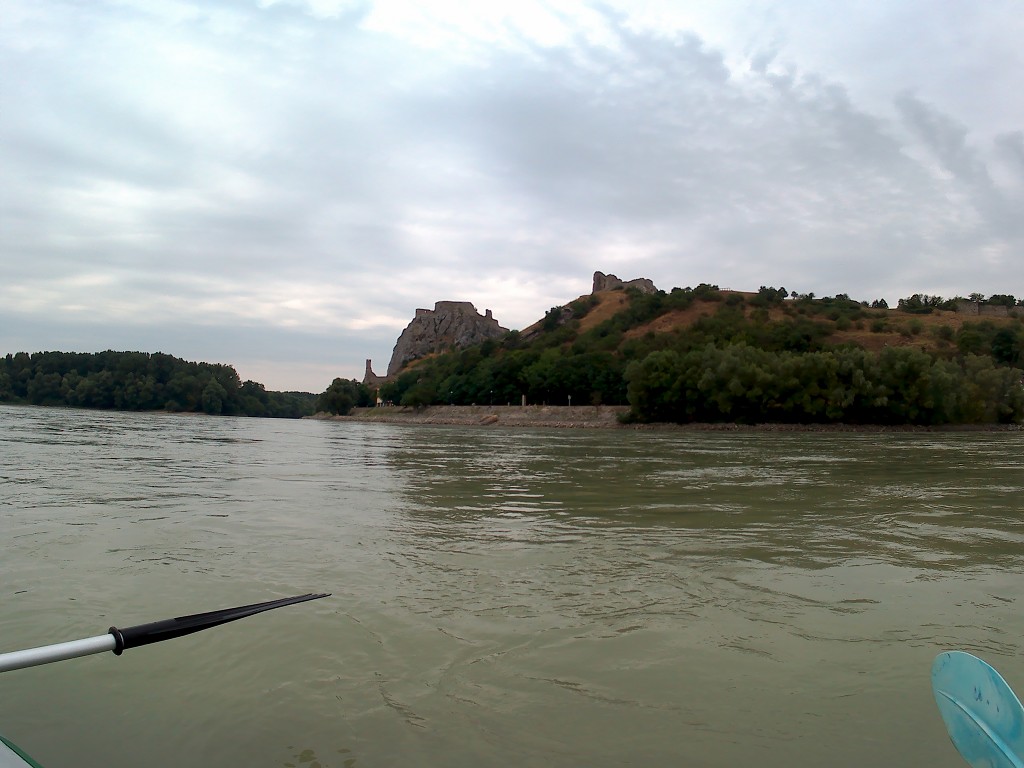
The Devín castle looks really cool and I’d like to visit it. What spoils the view is this derelict building right in front of it that must be an abandoned hotel. It’s called an “Amfiteáter” on my OSM map. Just look at it:
The Morava river itself doesn’t add much speed to the Danube, which is still fine for us anyway. We keep to the right-hand (Austrian) side of the Danube because that’s where we’ll need to get out today. There are still many speedbumps in the river that force us to paddle through the shipping lane.
The Second Encounter and our Arrival in Bratislava
We’ve left Devín behind us at 10:20 and paddle past some kind of mine or industrial area. Jonas’ alarm goes off at 10:25, which warns us that the Twin City Liner is now leaving Bratislava to travel back to Vienna. At 10:30 we’re out of the river on the right-hand shore between two speedbumps. Jonas grabs the chocolate to see if he might have put the chocolate back, but he didn’t. He eats the last chocolate while still morning the other. At least we dispose of the trash correctly this time.
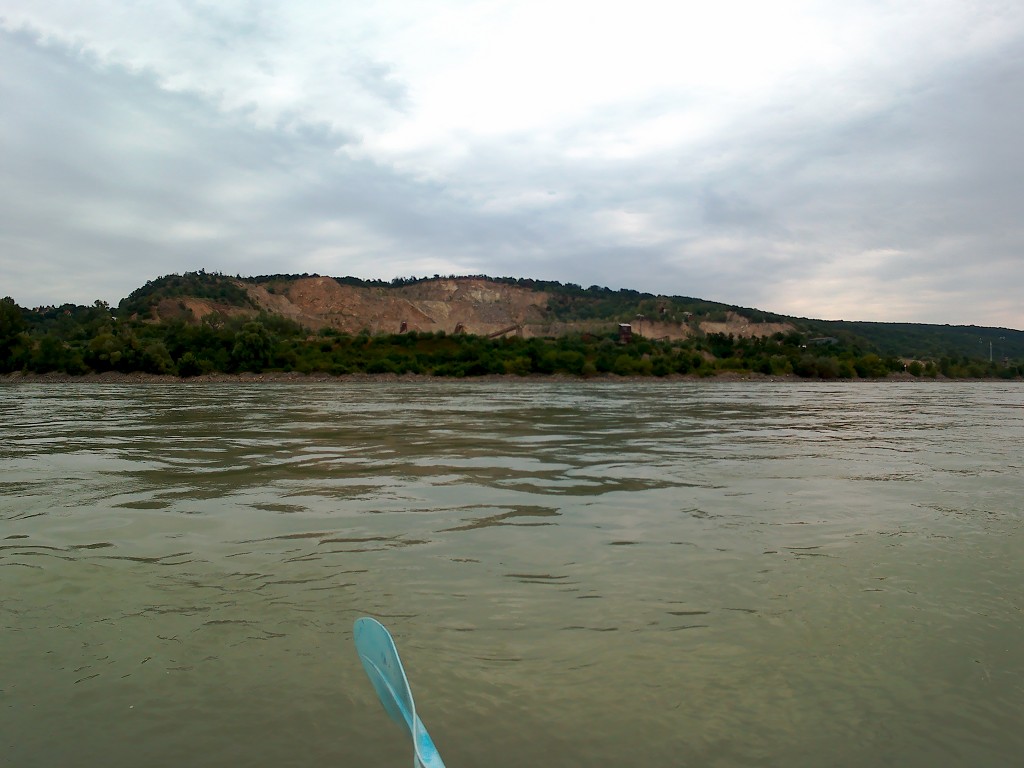
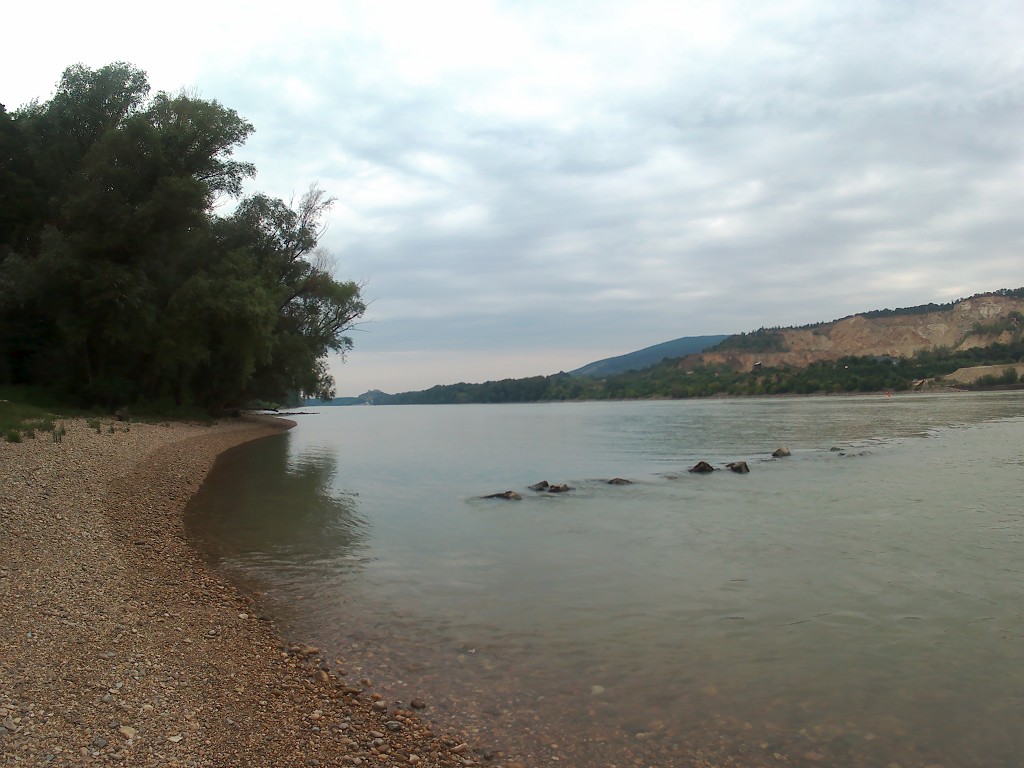
The ferry passes us by again and we’re holding on to our boat. Again, the boat splashes a lot of water into Jonas’ seat. This irritates us, but in the end, is not such a big deal because this is our last encounter with the Twin City Liner; we’re only a few kilometers outside of Bratislava. Coming to think about it, it’s funny that the first and the last thing we did in Austria was pee on its shores.


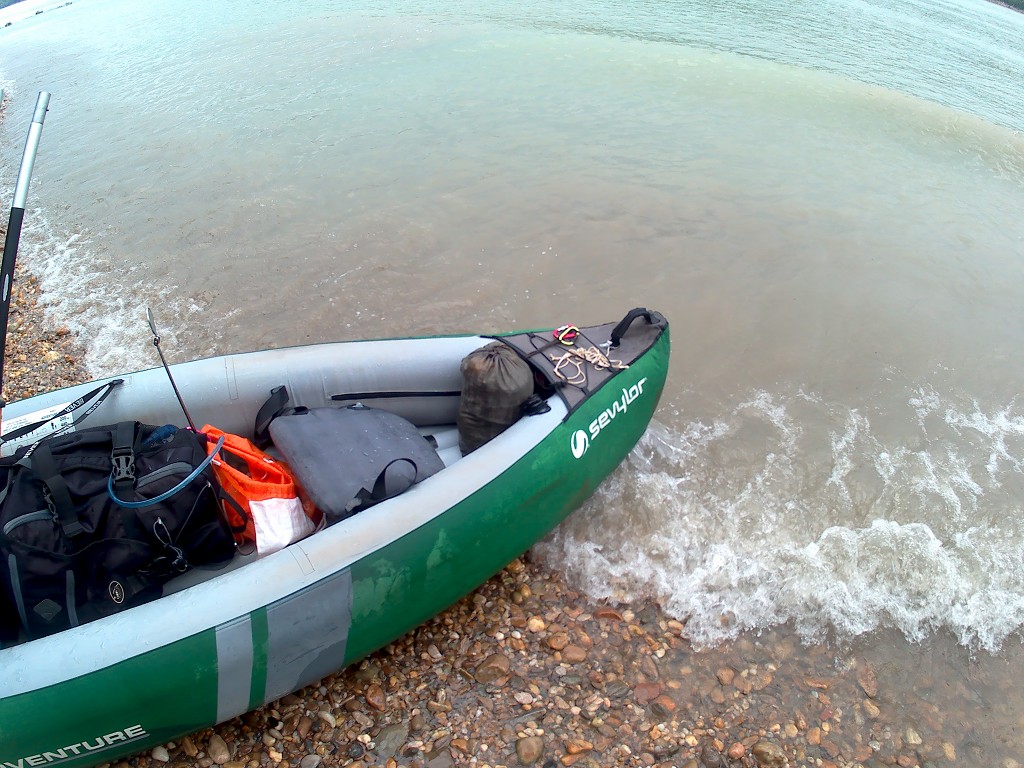
We continue paddling at 10:50. Today might become an early arrival record if we land in Bratislava before 11:30. Jonas checks the map and says that’s not very likely to happen. We paddle through a river bend the first building we see of Bratislava is its castle (Bratislavský hrad). What a spectacular entry!

There’s one big bridge we need to pass under. Two kilometers before that bridge, the right-hand shore of the Danube also becomes Slovakian territory. I’m following the shore closely with my eyes to see if I can spot the border marker. It’s visible, but hard to photograph. Welcome to Slovakia!
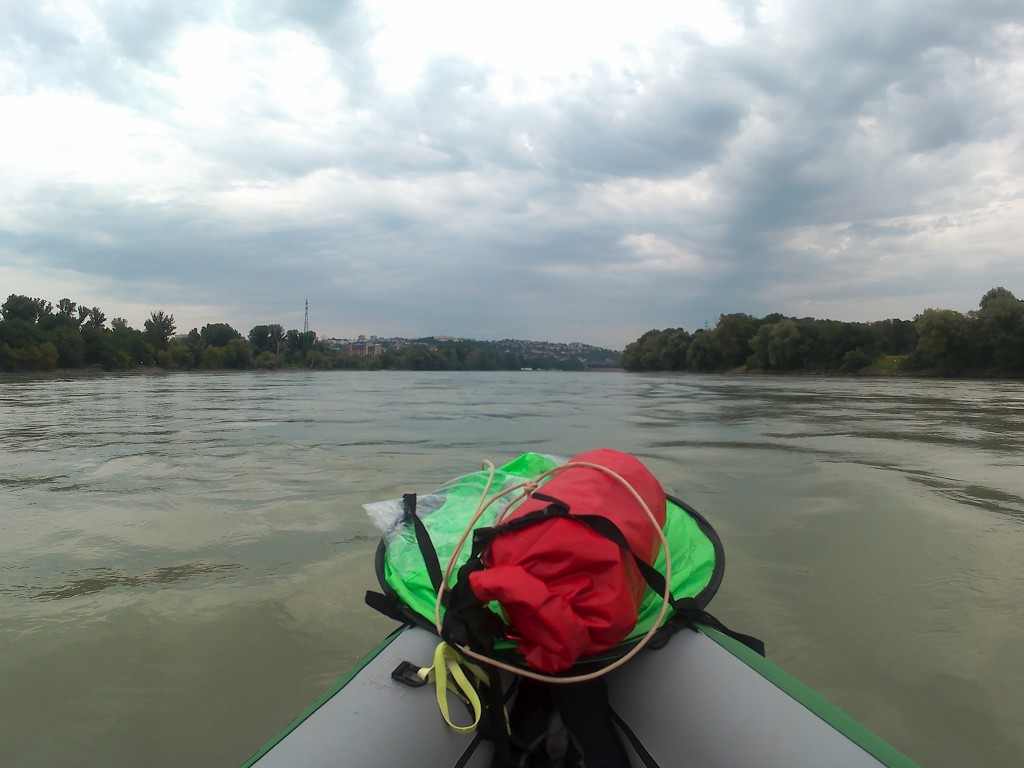

We see a big TV tower whose name we don’t know on the left shore. Finally, we see the Most Slovenského Národného Povstania (Most SNP – Bridge of the Slovak National Uprising), better known as “that bridge with the UFO saucer on top” or the New Bridge (nový most). The last time I laid my eyes on this architectural beauty, I was 22 years old and hadn’t even quit university yet. I love this bridge with a burning passion. I am so fucking happy to be here.


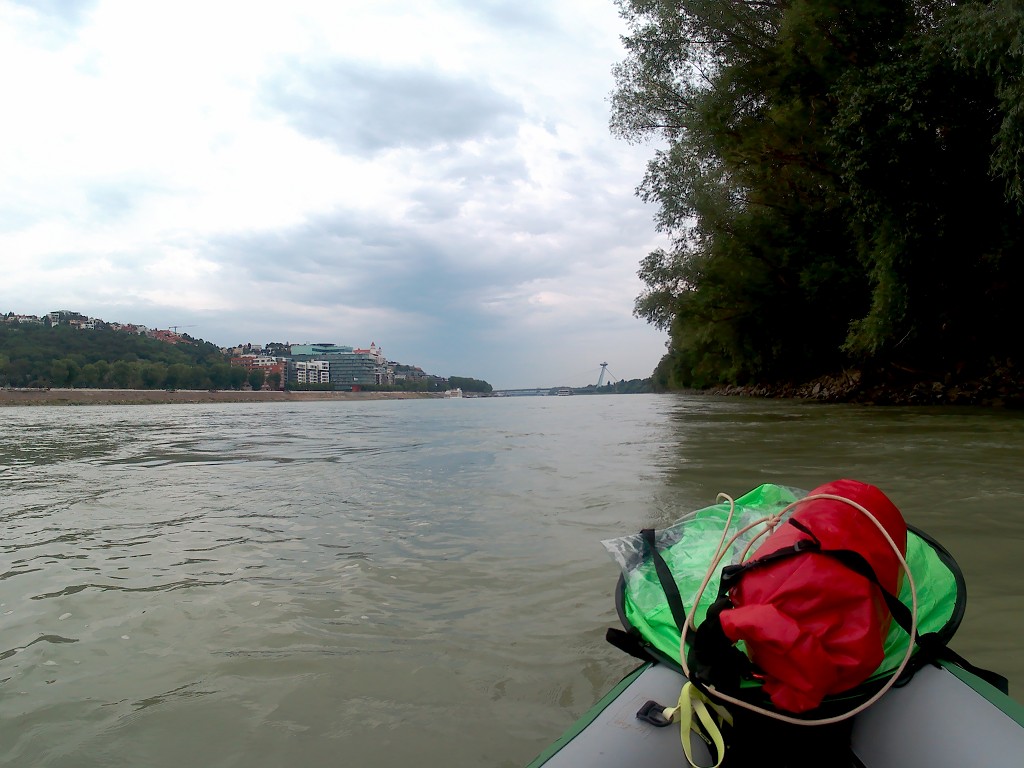

A double-wide barged cargo ship overtakes us traveling downstream and beeps angrily under the first bridge at two cruise ships who are maneuvering awkwardly under the UFO bridge. The cargo ship seems to honk to say “Don’t you fucking turn around here! I am coming you bastards!” And yes, the cruise ships move out of its way so the cargo ship can get past this fuckery.
There are many cruise ships turning around, landing, or departing from their docks here. It’s really busy. Jonas and I check the map to see that we’re within a few hundred meters of our landing spot before the UFO bridge. We see the pontoons a blog had told us about and turn our boat around to land. It’s 11:45 when Jonas gets out of the boat and steps onto the wobbly pontoon.
Welcome to Bratislava
We’re stripping our boat when a man boldly goes for a swim in the strong current from the pontoon. It’s a fascinating sight. This man seems to really know what he’s doing.
The pontoon is owned by the Nemecký veslársky klub, which translates to ‘German rowing club’. I’m not sure what makes this rowing club German. Upon the embankment, it threatens to rain, so we start packing up everything we can.
Jonas messages our Airbnb host in Bratislava to tell that we’ve arrived more than four hours earlier than anticipated. Since it’s so cloudy, we won’t be able to dry our boat quickly anyway, so we pack it up kind of wet. When it’s a sunny day we’ll take our boat to a park to dry it properly. It doesn’t exactly fit the CabinMAX, but it’s stable enough to carry it a short distance. Jonas orders a Bolt taxi to our location and before we know it a grumpy taxi driver shows up. We stuff the trunk with our clean-enough backpacks and take the paddles inside the cab.
The route to get to the other side of Bratislava is really crazy inefficient. We’re driving at least 6 kilometers to cover a distance that would have been one kilometer on foot. If I could, I would have walked it, but I’m still in a lot of pain from the injuries I collected from carrying this new setting with the extra paddle. Jonas contemplated leaving the black paddle – he finally made up his mind – at the rowing club, but I told him not to because giving rowing oar people a kayak paddle is… kind of offensive?
It’s probably offensive.
We arrive at our street in the Old Town (Staré Mesto) of Bratislava next to the embassy of the USA. They have some serious security there. We enter the building and wait on the ground floor for our host to show up.
She’s a very friendly lady who speaks good English and helps us navigate the building and its many doors and hallways. We arrive in an apartment that is indeed “better than in the pictures” like one review read. It’s super spacious and has everything we need for a price not at all comparable to anything we had in Austria.
Again, I’m super happy to be here.
We spend the next hours relaxing, unpacking, and showering before we go to the supermarket to buy supplies. We pick a (presumably) Slovakian supermarket chain named Terno. In the city center, it’s only a rather small shop and we have quite some troubles finding everything we want. I love going to foreign supermarkets, but the first time it’s always a bit tricky to see what kind of selection they have. Being a sort of vegetarian doesn’t make things easier. But knowing Russian, I can understand the contents of most products.
Back at the Airbnb, we unwind some more with snacks and Netflix. Jonas tests the internet speed and it yields an incredible 149 megabit per second. I have never seen these speeds. Not in Europe. Not anywhere in the world. The rule of ‘the further you move east in Europe, the faster the internet’ seems to hold up pretty well for now.
We’re staying in Bratislava for one whole week. This time, I really hope to publish some of the stories I’ve written since Linz!
Feel Free to Share this Article on Social Media!
